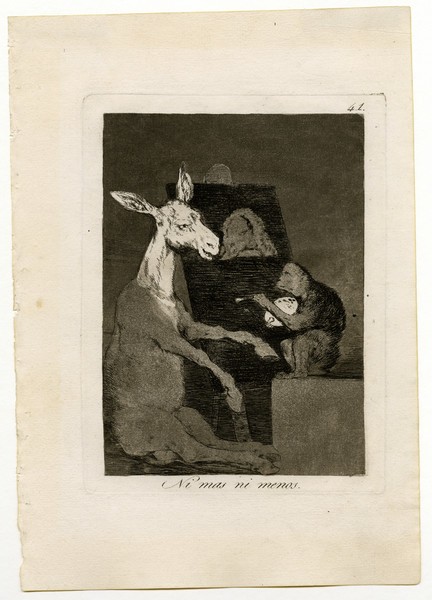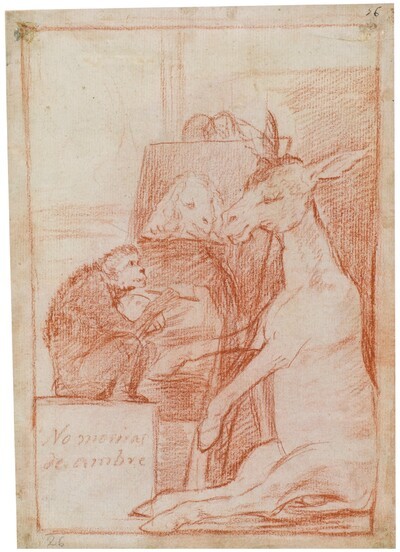- Cronología
- Ca. 1797 - 1799
- Dimensiones
- 200 x 152 mm
- Técnica y soporte
- Aguafuerte, aguatinta bruñida, punta seca y buril
- Reconocimiento de la autoría de Goya
- Undisputed work
- Ficha: realización/revisión
- 14 Dec 2010 / 29 May 2024
- Inventario
- 225
Ni mas ni menos. (at the bottom)
41. (in the upper right-hand corner)
See Francisco de Goya y Lucientes, Painter.
There is known evidence of pre-lettered condition with touches of graphite on the front hooves of the donkey. On the upper part of the print there is an inscription that reads El Asno ("The Donkey"), although it has been partially erased so that it is barely legible.
A preparatory drawing for this engraving is in the Prado Museum.
Seated on a bucket, a monkey acts as a painter, holding a brush in his hand and a palette in the other. He is portraying an ass posing before him, although the ape depicts him in a different way, dressed in a golilla as if he were a magistrate.
Goya uses aquatint throughout the composition except for the donkey's head and the ape's palette. The drypoint is clearly visible on the donkey's nose and the burin on the monkey's back. The painter has left the donkey's head lighter than the rest to emphasise that the monkey's portrait of him does not coincide with the true image of the animal.
In this engraving there is a difference with respect to the drawing that implies some different nuances in the interpretation of the two works. The fact that he is sitting on a bucket on which we can read " Do not die of hunger" leads us to think that in the drawing the object of the mockery is the monkey, while in the engraving the satire is directed at the donkey. This mockery of the donkey is very well explained in the manuscripts on the Caprices series of which we are aware, especially the one in the National Library, which states the following: "An animal that is portrayed will not cease to appear to be an animal for that reason, even if it is painted with its gourd and affected gravity".
The monopainter represents his clients as they wish; thus the donkey tries, in the portrait painted by the false painter, to appear to be what he is not. He has therefore asked him to hide his donkey's ears under a wig, although he does not succeed in erasing his own nature.
Edith Helman believes that this Caprice should be related to the fable of The Painter in Fables in Castilian Verse by José Agustín Ibáñez de la Rentería (Bilbao, 1751-Lequeitio, 1826). In this text the writer narrates how a painter must accommodate himself to the tastes of his clientele in order not to starve to death, as the inscription on Goya's preparatory drawing reads.
Some specialists have seen in this image a satire of Manuel Godoy (Badajoz, 1767-Paris, 1851), who was portrayed by Antonio Carnicero (Salamanca, 1748-Madrid, 1814) according to his demands.
It is possible that one of the visual sources to which Goya may have had recourse for the engraving we are dealing with here is the painting by David Teniers entitled The Monkey Painter (1650, Prado Museum, Madrid) or perhaps he may have been familiar with the painting of the same title by Jean-Baptiste Simeon Chardin (Paris, 1699-Paris, 1779).
This print forms part of the series of "asnerías" that Goya produced between engravings Nos. 37 and 42 of The Caprices, in which this animal becomes the mechanism for censuring human stupidity.
The plate is preserved in the National Chalcography (no. 212).
-
Goya. Gemälde Zeichnungen. Graphik. TapisserienKunsthalle BaselBasle1953from January 23th to April 12th 1953cat. 229
-
De grafiek van GoyaRijksmuseum RijksprentenkabinetAmsterdam1970from November 13th 1970 to January 17th 1971cat. 34
-
Goya dans les collections suissesFundación Pierre GianaddaMartigny1982consultant editor Pierre Gassier. From June 12th to August 29th 1982cat. 52
-
Goya. La década de Los CaprichosMadrid1992organized by Real Academia de Bellas Artes de San Fernando sponsored by Fundación Central Hispano, Madrid, consultant editor Nigel Glendinnig. From October 26th 1992 to January 10th 1993cat. 135
-
Francisco de GoyaMuseo d'Arte ModernaLugano1996exhibition celebrated from September 22nd to November 17th.cat. 41, p.68
-
Ydioma universal: Goya en la Biblioteca NacionalBiblioteca NacionalMadrid1996from September 19th to December 15th 1996cat. 133
-
Francisco Goya. Sein leben im spiegel der graphik. Fuendetodos 1746-1828 Bordeaux. 1746-1996Galerie KornfeldBern1996from November 21st 1996 to January 1997cat. 47
-
Goya artista de su tiempo y Goya artista únicoThe National Museum of Western ArtTokyo1999from December 1st to July 3th 1999cat. 119
-
Goya. La imagen de la mujerMuseo Nacional del PradoMadrid2001from October 30th 2001 to February 10th 2002. Exhibitied also at the National Gallery of Art, Washington, March 10th to June 2nd 2002, consultant editor Francisco Calvo Serrallerp.85, fig. 31
-
Goya e la tradizione italianaFondazione Magnani RoccaMamiano di Traversetolo (Parma)2006consultant editors Fred Licht and Simona Tosini Pizzetti. From September 9th to December 3th 2006cat. 41, p.156
-
Goya. Opera graficaPinacoteca del Castello di San GiorgioLegnano2006exhibition celebrated from December 16th 2006 to April 1st 2007p.34
-
Goya et la modernitéPinacothèque de ParisParís2013from October 11st 2013 to March 16th 2014cat. 146
-
Goya engravings and lithographs, vol. I y II.OxfordBruno Cassirer1964p.113, cat. 76
-
Vie et ouvre de Francisco de GoyaParísOffice du livre1970p.181, cat. 532
-
Goya, 1746-1828. Biografía, estudio analítico y catálogo de sus pinturasBarcelonaEdiciones Polígrafa s.a.1970p.395, fig. 636
-
Goya, la década de los caprichos: dibujos y aguafuertesMadridReal Academia de Bellas Artes de San Fernando1992pp.225-227, cat. 134-135
-
Catálogo de las estampas de Goya en la Biblioteca NacionalMadridMinisterio de Educación y Cultura, Biblioteca Nacional1996p.95, cat. 130
-
El libro de los caprichos: dos siglos de interpretaciones (1799-1999). Catálogo de los dibujos, pruebas de estado, láminas de cobre y estampas de la primera ediciónMadridMuseo Nacional del Prado1999pp.230-233
-
Goya. Die Kunst der FreiheitMunichVerlag C. H. Beck2000p.94, fig. 32
-
ParísPinacoteca de París2013p. 208
-
Goya. In the Norton Simon MuseumPasadenaNorton Simon Museum2016pp. 42-75

